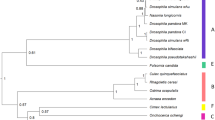Abstract
Wolbachia is an obligatory, maternally inherited intracellular bacterium, known to infect a wide range of arthropods. It has been implicated in causing cytoplasmic incompatibility (CI), parthenogenesis, the feminization of genetic males and male-killing in different hosts. However, the molecular mechanisms by which this fastidious bacterium causes these reproductive abnormalities have not yet been determined. In this study, we report on the cloning and characterization of the gene encoding phage-related tail protein (PrTP) from Wolbachia in Drosophila melanogaster CantonS (wMelCS) and from Wolbachia in Drosophila melanogaster yw67c23 (wMel) by representational difference analysis (RDA) and ligation-mediated PCR (LM-PCR). The functionality of a bipartite nuclear localization signal sequence (NLS) of the gene was also successfully tested in Drosophila S2 cells. PrTP expression in various strains of Wolbachia was investigated. Our results suggest that PrTP may not induce CI directly. However, the existence of prtp provided direct evidence of phage-mediated horizontal gene transfer (HGT) that might play an important role in a variety of reproductive abnormalities of Wolbachia.
Similar content being viewed by others
References
Werren, J. H., Windsor, D., Guo, L. R., Distribution of Wolbachia among neotropical arthropods, Proc. R. Soc. Lond. B, 1995, 262: 197.
Jeyaprakash, A., Hoy, M. A., Long PCR improves Wolbachia DNA amplification: wsp sequences found in 76% of sixty-three arthropod species, Insect Mol. Biol., 2000, 9: 393.
Werren, J. H., Biology of Wolbachia, Annu. Rev. Entomol., 1997, 42: 587.
Beard, C. B., O’Neill, S. L., Tesh, R. B. et al., Modification of arthropod vector competence via symbiotic bacteria, Parasitol Today, 1993, 9: 179.
Sinkins, S. P., Curtis, C. F., O’Neill, S. L., The potential application of inherited symbiont systems to pest control, In Influential Passengers: Inherited Microorganisms and Arthropod Reproduction (eds, O’Neill, S. L., Hoffmann, A. A., Werren, J. H.), Oxford: Oxford university Press, 1997, 155.
Lisitsyn, N., Lisitsyn, N., Wigler, M., Cloning the differences between two complex genomes, Science, 1993, 259: 946.
Zhou, W., Rousset, F., O’Neill, S. L., Phylogeny and PCR-based classification of Wolbachia strains using wsp gene sequences, Proc. R. Soc. Lond. B, 1998, 265: 509.
Altschul, S. F., Madden, T. L., Schaffer, A. A. et al., Gapped BLAST and PSI-BLAST: a new generation of protein database search programs, Nucleic Acids Research, 1997, 25: 3389.
Braig, H. R., Zhou, W., Dobson, S. L. et al., Cloning and characterization of a gene encoding the major surface protein of the bacterial endosymbiont Wolbachia pipientis, J. Bacteriol., 1998, 180: 2373.
Hauser, F., Nothacker, H. P., Grimmelikhuijzen, C. J., Molecular cloning, genomic organization and developmental regulation of a novel receptor from Drosophila melanogaster structurally related to members of the TSH, FSH, LH/CG receptor family from mammals, J. Biol. Chem., 1997, 272: 1002.
Kannangara, C. G., Gough, S. P., Bruyant, P. et al., tRNA(Glu) as a cofactor in delta-aminolevulinate biosynthesis: steps that regulate chlorophyll synthesis, Trends Biochem. Sci., 1988, 13: 139.
Braun, E. L., Fuge, E. K., Padilla, P. A. et al., A stationary-phase gene in Saccharomyces cerevisiae is a member of a novel, highly conserved gene family, J. Bacteriol., 1996, 178: 6865.
Makino, K., Ishii, K., Yasunaga, T. et al., Complete nucleotide sequences of 93-kb and 3.3-kb plasmids of an enterohemorrhagic Escherichia coli O157:H7 derived from Sakai outbreak, DNA Res, 1998, 5: 1.
Craggs, G., Kellie, S., A functional nuclear localization sequence in the C-terminal domain of SHP-1, J. Biol. Chem., 2001, 276: 23719.
Satom, N., Ohta, N., DNA-binding specificity and dimerization of the DNA-binding domain of the PEND protein in the chloroplast envelop membrane, Nucleic Acids Research, 2001, 29: 2244.
Miao, E. A., Miller, S. I., Bacteriophages in the evolution of pathogen-host interactions, Proc. Natl. Acad. Sci. USA, 1999, 96: 9452.
Masui, S., Kamoda, S., Sasaki, T. et al., Distribution and evolution of Bacteriophage WO in Wolbachia, the endosymbiont causing sexual alternation in Arthropods, J. Mol. Evol., 2000, 51: 491.
Ogata, H., Audic, S., Renesto-Audiffren, P. et al., Mechanisms of evolution in Rickettsia conorii and R. Prowazekii, Science, 2001, 293: 2093.
Stouthamer, R., Breeuwer, J. A., Hurst, G. D., Wolbachia pipientis: microbial manipulator of arthropod reproduction, Annu. Rev. Microbiol., 1999, 53: 71.
Van Meer, M. M., Witteveldt, J., Stouthamer, R., Phylogeny of the arthropod endosymbiont Wolbachia based on the wsp gene, Insect Mol. Biol., 1999, 8: 399.
Sun, L. V., Fosterm, J. M., Tzertzinis, G. et al., Determination of Wolbachia genome size by pulsed-field gel electrophoresis, J. Bacteriol., 2001, 83: 2219.
Hale, L. R., Singh, R. S., A comprehensive study of genic variation in natural populations of Drosophila melanogaster. IV. Mitochondrial DNA variation and the role of history vs. selection in the genetic structure of geographic populations, Genetics, 1991, 129: 103.
Turelli, M., Hoffmannn, A. A., Mckechnie, S. W., Dynamics of cytoplasmic incompatibility and mtDNA variation in natural Drosophila simulans populations, Genetics, 1992, 132: 713.
Rousset, F., Soliganc, M., Evolution of single and double Wolbachia symbioses during speciation in the Drosophila simulans complex, Proc. Natl. Acad. Sci. USA, 1995, 92: 6389.
Author information
Authors and Affiliations
Corresponding author
About this article
Cite this article
Kang, L., Sun, L., Yu, H. et al. Cloning and characterization of a gene encoding phagerelated tail protein (PrTP) of endosymbiont Wolbachia . Chin.Sci.Bull. 47, 1451–1456 (2002). https://doi.org/10.1360/02tb9320
Received:
Issue Date:
DOI: https://doi.org/10.1360/02tb9320




